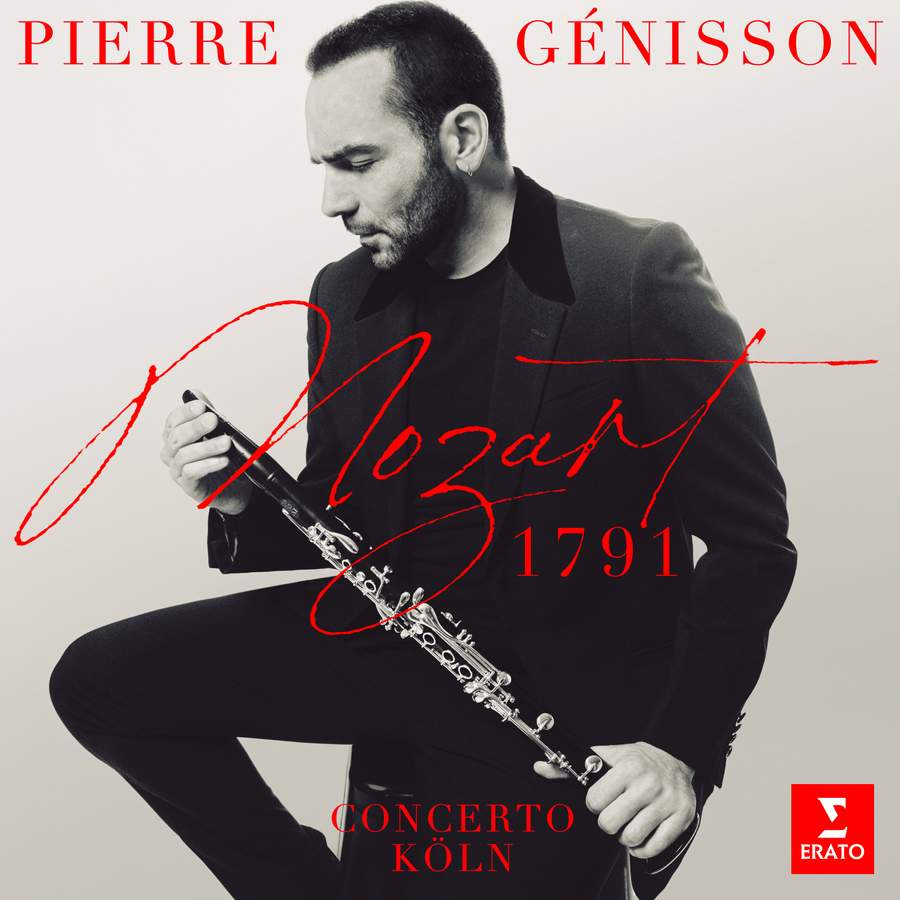'Mozart 1791'
View record and artist detailsRecord and Artist Details
Genre:
Orchestral
Label: Erato
Magazine Review Date: 01/2024
Media Format: CD or Download
Media Runtime: 59
Mastering:
DDD
Catalogue Number: 5419773233

Tracks:
| Composition | Artist Credit |
|---|---|
| (Le) nozze di Figaro, '(The) Marriage of Figaro', Movement: Voi che sapete |
Wolfgang Amadeus Mozart, Composer
Concerto Köln Jakob Lehmann, Conductor Pierre Génisson, Clarinet |
| Così fan tutte, Movement: ~ |
Wolfgang Amadeus Mozart, Composer
Concerto Köln Jakob Lehmann, Conductor Pierre Génisson, Clarinet |
| Così fan tutte, Movement: Soave sia il vento |
Wolfgang Amadeus Mozart, Composer
Concerto Köln Jakob Lehmann, Conductor Pierre Génisson, Clarinet |
| Concerto for Clarinet and Orchestra |
Wolfgang Amadeus Mozart, Composer
Concerto Köln Jakob Lehmann, Conductor Pierre Génisson, Clarinet |
| (La) Clemenza di Tito, Movement: Parto, parto, ma tu, ben mio |
Wolfgang Amadeus Mozart, Composer
Concerto Köln Jakob Lehmann, Conductor Karine Deshayes, Mezzo soprano Pierre Génisson, Clarinet |
| (La) Clemenza di Tito, Movement: ~ |
Wolfgang Amadeus Mozart, Composer
Concerto Köln Jakob Lehmann, Conductor Karine Deshayes, Mezzo soprano Pierre Génisson, Clarinet |
| Requiem, Movement: Lacrimosa |
Wolfgang Amadeus Mozart, Composer
Bruno Fontaine, Fender rhodes Concerto Köln Jakob Lehmann, Conductor Pierre Génisson, Clarinet |
Author: David Threasher
Mozart’s Clarinet Concerto is most commonly coupled on recordings with the Clarinet Quintet or with a complementary concerto by another composer. Having already recorded the Quintet on an album entitled ‘How I Met Mozart’ (Aparté, 8/17), Pierre Génisson opts for a more personal programme, surrounding the Concerto with the two arias from La clemenza di Tito containing single-reed obbligatos, plus arrangements of arias (and a trio) from The Marriage of Figaro and Così fan tutte.
‘Mozart 1791’ is the title, which is only true as far as the Clarinet Concerto and the Clemenza arias (and the disc’s surprise envoi) are concerned. Nevertheless, the other excerpts are pleasing in their own right, the arrangements by Bruno Fontaine extending the range of the vocal line, exploiting the capability of Génisson’s clarinet to ornament with far greater agility than any soprano could manage.
The Concerto itself is performed in a reconstructed version for the basset clarinet, with its extension down to low (written) C, where it grumbles most satisfyingly. What is missing, though, is the ‘ring’ of the instrument’s upper range. Génisson is so keen to demonstrate the instrument’s ability to play super-pianissimos that barely register even as a whisper that he rather underplays the moments of showmanship offered by virtuoso high-lying passages. To hear a period instrument really sing out in its upper range, turn to Wolfgang Meyer (with Harnoncourt – Warner, 3/01), Anthony Pay (with the AAM – L’Oiseau-Lyre, 5/86) or Colin Lawson (with The Hanover Band – Nimbus, 7/90).
A concerto, then painted in exquisite, subtle pastels, rather than brighter hues. A shaft of sunlight in a predominantly dark, alto-register programme is provided by Karine Deshayes, imperious in the two Clemenza scenas. Génisson plays a range of instruments: a standard B flat clarinet, basset clarinets in A and B flat and a basset-horn, all pictured in the booklet. And that surprise envoi? The ‘Lacrimosa’ from the Requiem accompanied by arranger Bruno Fontaine on a Fender Rhodes, bringing something mildly hallucinogenic to this poignant piece. I have no idea why it works, but for reasons I can’t explain, it lingers long in the memory.
Discover the world's largest classical music catalogue with Presto Music.

Gramophone Digital Club
- Digital Edition
- Digital Archive
- Reviews Database
- Full website access
From £8.75 / month
Subscribe
Gramophone Full Club
- Print Edition
- Digital Edition
- Digital Archive
- Reviews Database
- Full website access
From £11.00 / month
Subscribe
If you are a library, university or other organisation that would be interested in an institutional subscription to Gramophone please click here for further information.




